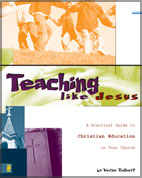
Should parents allow children to eat only the foods they prefer? If they only like ice cream and french fries, would that be acceptable? Of course not! Their health would suffer from such an unbalanced diet even with a vitamin supplement. Parents discover the foods children prefer and try to continue to expand that variety so balance can be offered.
In the same way, Sunday School teachers should discover learning style preferences (ways attenders learn best). Teachers do so in order to be even more effective in leading them to meet God in Bible study and communicating the truth of God’s Word. But revolutionary teachers also continue to expose learners to a variety of teaching methods in order to expand possibilities of achieving balance while addressing preferences.
Dr. La Verne Tolbert is adjunct professor at Azuza Pacific University‘s Haggard Graduate School of Theology, Director of Christian Education Ministries at Crenshaw Christian Center in Los Angeles, and Founder and President of Teaching Like Jesus Ministries. Dr. Tolbert has written a great book entitled Teaching Like Jesus: A Practical Guide to Christian Education in Your Church. Her focus on principles from Jesus and practices for ministry is a needed blend in churches. She has given me permission to share a “Show, Tell, Do” activity from her book that can be helpful to Sunday School teachers and small group leaders.
This is the first page of the full “Show, Tell, Do” chart from pages 66-67. The second page will be shared in my next blog entry. Place a checkmark in the column that best describes that teaching method. Note: Several of these activities may fall into two or even three categories. Choose the category that is dominant.
|
Show
|
Tell
|
Do
|
||
|
(Visual)
|
(Auditory)
|
(Kinesthetic)
|
||
|
1.
|
Conduct a demonstration | |||
|
2.
|
Display a clip from television | |||
|
3.
|
Do no-talk teacher* (see book) | |||
|
4.
|
Prepare a speech or lecture | |||
|
5.
|
Use an overhead projector | |||
|
6.
|
Have small-group discussion | |||
|
7.
|
Complete this story | |||
|
8.
|
Write a skit or play | |||
|
9.
|
Play games | |||
|
10 .
|
Take a trip | |||
|
11.
|
Make a poster | |||
|
12.
|
Listen to a testimony | |||
| 13. | Sing a solo or group song | |||
|
14.
|
Go for a hospital visit | |||
|
15.
|
Listen to a song on a CD | |||
|
16.
|
Draw or color | |||
|
17.
|
Visualize or imagine | |||
|
18.
|
Paraphrase a passage | |||
|
19.
|
Read in unison | |||
|
20.
|
Do question-and-answer | |||
|
21.
|
Discuss in neighbor nudge | |||
|
22.
|
Cook a meal/eat a meal | |||
|
23.
|
Say a sentence prayer | |||
|
24.
|
Conduct an interview | |||
|
25.
|
Have a puppet show | |||
|
26.
|
Keep a journal | |||
|
27.
|
Tell an account with flannelgraph | |||
|
28.
|
See a movie | |||
|
29.
|
Complete a puzzle | |||
|
30.
|
Play the Bible drill | |||
|
31.
|
Memorize a verse | |||
|
32.
|
Repeat the Bible account | |||
|
33.
|
Make arts and crafts | |||
|
34.
|
Take a test |
How many of these methods have you used? In a class of six people, you will usually find all three learning style preferences (visual, auditory, and kinesthetic) present. Work to offer a balanced diet of the teaching methods you use. In Part 2 of this series, I’ll share the second page of this activity. Let me offer a challenge Dr. Tolbert shared on page 65,
Remember that the worst teaching method to use is the one you use all the time!
Also, let me challenge you to get her book. She offers lots more practical help. Don’t be mediocre in your teaching. Be revolutionary!
Leave a Reply